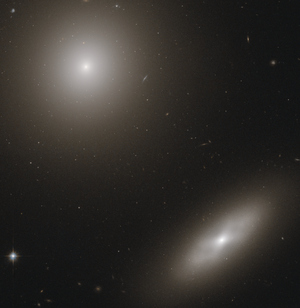NGC 1374
| Galaxie NGC 1374 | |
|---|---|
 | |
| NGC 1374 (oben links) und NGC 1375 (unten rechts) in einer Aufnahme des Hubble-Weltraumteleskops | |
| AladinLite | |
| Sternbild | Chemischer Ofen |
| Position Äquinoktium: J2000.0, Epoche: J2000.0 | |
| Rektaszension | 03h 35m 16,59s [1] |
| Deklination | −35° 13′ 34,5″ [1] |
| Erscheinungsbild | |
| Morphologischer Typ | E3[1] |
| Helligkeit (visuell) | 11,0 mag[2] |
| Helligkeit (B-Band) | 12,0 mag[2] |
| Winkelausdehnung | 2,7′ × 2,4′[2] |
| Positionswinkel | 124°[2] |
| Flächenhelligkeit | 13,1 mag/arcmin²[2] |
| Physikalische Daten | |
| Zugehörigkeit | Fornax-Cluster, LGG 96[1][3] |
| Rotverschiebung | 0.004316 ± 0.000007[1] |
| Radialgeschwindigkeit | (1294 ± 2) km/s[1] |
| Hubbledistanz H0 = 73 km/(s • Mpc) | (53 ± 4) · 106 Lj (16,1 ± 1,1) Mpc [1] |
| Durchmesser | 45.000 Lj[4] |
| Geschichte | |
| Entdeckung | John Herschel |
| Entdeckungsdatum | 29. November 1837 |
| Katalogbezeichnungen | |
| NGC 1374 • PGC 13267 • ESO 358-023 • MCG -06-08-029 • 2MASX J03351659-3513345 • SGC 33321-3523.5 • AM 0333-352 • GC 736 • h 2557 • FCC 147 • LDCE 249 NED018 | |
NGC 1374 ist eine elliptische Galaxie vom Hubble-Typ E im Sternbild Fornax am Südsternhimmel. Sie ist schätzungsweise 53 Millionen Lichtjahre von der Milchstraße entfernt und hat einen Durchmesser von etwa 45.000 Lj. Unter der Katalognummer FCC 147 ist sie als Mitglied des Fornax-Galaxienhaufens gelistet.
Im selben Himmelsareal befinden sich u. a. die Galaxien NGC 1373, NGC 1375, NGC 1378, NGC 1379.
Das Objekt wurde am 29. November 1837 von dem britischen Astronomen John Herschel entdeckt.[5]
Weblinks
Einzelnachweise
Auf dieser Seite verwendete Medien
Autor/Urheber: Judy Schmidt, Lizenz: CC BY 2.0
This pair of galaxies fits almost perfectly in one frame from Hubble's ACS. What caught my attention is the one on the lower right, NGC 1375. The X shaped nuclei found in some galaxies interests me. So far, I've only seen them in edgewise galaxies. The effect viewed from face on may be subtle enough that it is very difficult to notice or they could be bar structures I've failed to make the connection to so far. They are also called boxy or peanut-shaped but when imaged with Hubble the X becomes obvious. See <a href="http://cdsads.u-strasbg.fr/cgi-bin/nph-bib_query?2013MNRAS.431.3060E&db_key=AST&nosetcookie=1" rel="nofollow">this paper</a> for information from actual scientists rather than my own novice observations. I did some extra processing to make the strange nucleus of NGC 1375 more apparent.
These galaxies were imaged for <a href="http://archive.stsci.edu/proposal_search.php?mission=hst&id=10911" rel="nofollow">Proposal 10911</a>.
Red: HST_10911_01_ACS_WFC_F814W_sci Green: Pseudo Blue: HST_10911_01_ACS_WFC_F475W_sci
North is NOT up. It is 39.1° counter-clockwise from up.